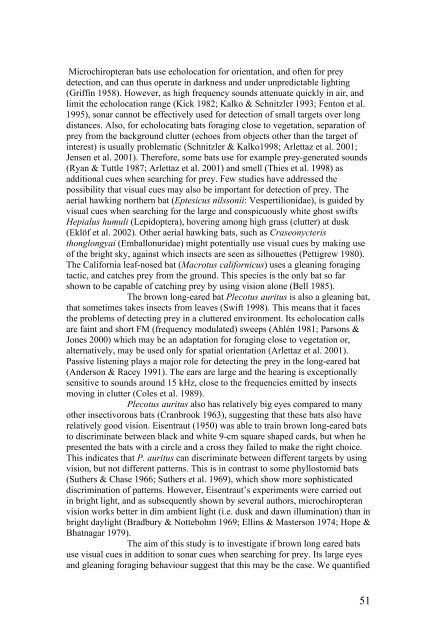Vision in echolocating bats - Fladdermus.net
Vision in echolocating bats - Fladdermus.net
Vision in echolocating bats - Fladdermus.net
You also want an ePaper? Increase the reach of your titles
YUMPU automatically turns print PDFs into web optimized ePapers that Google loves.
Microchiropteran <strong>bats</strong> use echolocation for orientation, and often for prey<br />
detection, and can thus operate <strong>in</strong> darkness and under unpredictable light<strong>in</strong>g<br />
(Griff<strong>in</strong> 1958). However, as high frequency sounds attenuate quickly <strong>in</strong> air, and<br />
limit the echolocation range (Kick 1982; Kalko & Schnitzler 1993; Fenton et al.<br />
1995), sonar cannot be effectively used for detection of small targets over long<br />
distances. Also, for echolocat<strong>in</strong>g <strong>bats</strong> forag<strong>in</strong>g close to vegetation, separation of<br />
prey from the background clutter (echoes from objects other than the target of<br />
<strong>in</strong>terest) is usually problematic (Schnitzler & Kalko1998; Arlettaz et al. 2001;<br />
Jensen et al. 2001). Therefore, some <strong>bats</strong> use for example prey-generated sounds<br />
(Ryan & Tuttle 1987; Arlettaz et al. 2001) and smell (Thies et al. 1998) as<br />
additional cues when search<strong>in</strong>g for prey. Few studies have addressed the<br />
possibility that visual cues may also be important for detection of prey. The<br />
aerial hawk<strong>in</strong>g northern bat (Eptesicus nilssonii: Vespertilionidae), is guided by<br />
visual cues when search<strong>in</strong>g for the large and conspicuously white ghost swifts<br />
Hepialus humuli (Lepidoptera), hover<strong>in</strong>g among high grass (clutter) at dusk<br />
(Eklöf et al. 2002). Other aerial hawk<strong>in</strong>g <strong>bats</strong>, such as Craseonycteris<br />
thonglongyai (Emballonuridae) might potentially use visual cues by mak<strong>in</strong>g use<br />
of the bright sky, aga<strong>in</strong>st which <strong>in</strong>sects are seen as silhouettes (Pettigrew 1980).<br />
The California leaf-nosed bat (Macrotus californicus) uses a glean<strong>in</strong>g forag<strong>in</strong>g<br />
tactic, and catches prey from the ground. This species is the only bat so far<br />
shown to be capable of catch<strong>in</strong>g prey by us<strong>in</strong>g vision alone (Bell 1985).<br />
The brown long-eared bat Plecotus auritus is also a glean<strong>in</strong>g bat,<br />
that sometimes takes <strong>in</strong>sects from leaves (Swift 1998). This means that it faces<br />
the problems of detect<strong>in</strong>g prey <strong>in</strong> a cluttered environment. Its echolocation calls<br />
are fa<strong>in</strong>t and short FM (frequency modulated) sweeps (Ahlén 1981; Parsons &<br />
Jones 2000) which may be an adaptation for forag<strong>in</strong>g close to vegetation or,<br />
alternatively, may be used only for spatial orientation (Arlettaz et al. 2001).<br />
Passive listen<strong>in</strong>g plays a major role for detect<strong>in</strong>g the prey <strong>in</strong> the long-eared bat<br />
(Anderson & Racey 1991). The ears are large and the hear<strong>in</strong>g is exceptionally<br />
sensitive to sounds around 15 kHz, close to the frequencies emitted by <strong>in</strong>sects<br />
mov<strong>in</strong>g <strong>in</strong> clutter (Coles et al. 1989).<br />
Plecotus auritus also has relatively big eyes compared to many<br />
other <strong>in</strong>sectivorous <strong>bats</strong> (Cranbrook 1963), suggest<strong>in</strong>g that these <strong>bats</strong> also have<br />
relatively good vision. Eisentraut (1950) was able to tra<strong>in</strong> brown long-eared <strong>bats</strong><br />
to discrim<strong>in</strong>ate between black and white 9-cm square shaped cards, but when he<br />
presented the <strong>bats</strong> with a circle and a cross they failed to make the right choice.<br />
This <strong>in</strong>dicates that P. auritus can discrim<strong>in</strong>ate between different targets by us<strong>in</strong>g<br />
vision, but not different patterns. This is <strong>in</strong> contrast to some phyllostomid <strong>bats</strong><br />
(Suthers & Chase 1966; Suthers et al. 1969), which show more sophisticated<br />
discrim<strong>in</strong>ation of patterns. However, Eisentraut’s experiments were carried out<br />
<strong>in</strong> bright light, and as subsequently shown by several authors, microchiropteran<br />
vision works better <strong>in</strong> dim ambient light (i.e. dusk and dawn illum<strong>in</strong>ation) than <strong>in</strong><br />
bright daylight (Bradbury & Nottebohm 1969; Ell<strong>in</strong>s & Masterson 1974; Hope &<br />
Bhatnagar 1979).<br />
The aim of this study is to <strong>in</strong>vestigate if brown long eared <strong>bats</strong><br />
use visual cues <strong>in</strong> addition to sonar cues when search<strong>in</strong>g for prey. Its large eyes<br />
and glean<strong>in</strong>g forag<strong>in</strong>g behaviour suggest that this may be the case. We quantified<br />
51


